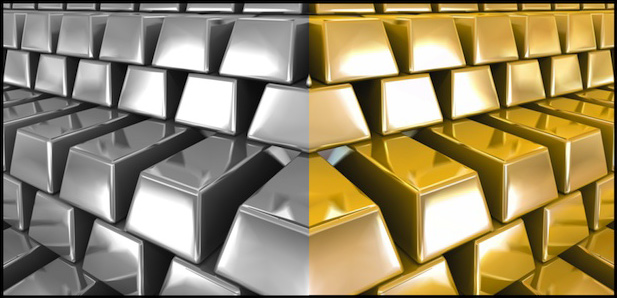Gold vs. Silver: What's the Best Investment?
Gold or silver? How do you choose which metal to invest in? Many people have their "pet" reasons why they choose one or the other. In this article I will list the main factors you should consider.
The Gold/Silver Ratio
The gold/silver price ratio chart is referred to often by analysts. See Figure 1 below.
Figure 1

SOURCE: GoldPrice.org
When this graph goes higher, the price of gold is going higher relative to silver. When this graph goes lower, the price of gold is going lower relative to silver. Historically the gold/silver price ratio has been between 15:1 and 17:1 depending how you are estimating. You can see clearly from the chart that it is much higher now. As this article is being written the ratio is over 70. Over the long term it should return to its historical average.
Bullion Available for Investment Annually
Annually, after industrial uses, there are approximately 120 million ounces of gold supply available for investment in jewelry, bars and coins. On the other hand, there is approximately 350 million ounces of silver available for investment after industrial uses. (Eric Sprott, 2013). So annually, there is approximately 3 times more silver available for investment than gold.
Coin Purchase Rates
The rate of purchase (in dollars) is much higher for silver than it is for gold. According to the US Mint, during 2014, customers spent fifty-five times more money purchasing silver bullion than gold bullion. (United States Mint, 2014)
Precious Metal Left in the Ground
To be clear about this next point lets define the word 'reserve'. A reserve is the economically mineable part of what is in the ground. There is approximately 55,000 tons of gold reserves in the world. (US Geological Survey, 2014a) There is approximately 530,000 tons of silver reserves in the world. (US Geological Survey, 2014b). That means there is approximately ten times more silver reserves in the ground than gold.
Precious Metal Above Ground
According to Thomson Reuters GFMS there are approximately 5.7 billion ounces of gold above ground. That's 176,000 tonnes times 32,151 ounces per tonne. (Reuters, 2014)
It is unclear how much above ground silver is still in existence, however estimates by John Embry and others are that there are around 1 billion ounces of above ground refined silver. Here's a quote from Sprott.com:
"Above-ground silver inventories were estimated to be as high as ten billion ounces at the end of the 1950’s with the vast proportion being held in the U.S. and China. In the succeeding fifty years, nearly 90% of this stockpile has disappeared, attesting to silver’s chronic supply-demand imbalance." (John Embry, 2014)
So there is approximately 5.7 times more gold above ground than silver!
 Gold and Silver Bars
Gold and Silver Bars
Silver is Consumed
A lot of the production of silver is consumed. In other words it is not economical to recycle in many cases. It has been estimated by some that 70% of all silver production is not recycled. Trace amounts of silver can be found in virtually all modern-day electronic devices. Recycling silver from these devices and similar uses is not economical at the current silver price.
To some degree gold is also consumed. But it has been estimated that only 2% of gold is not economical to recycle.
Summarizing the Gold vs. Silver debate:
- At the time this article is being written gold is 74 times more expensive than silver. Expect the gold price to return to its historical average of 15 to 17 times the price of silver over the long run.
- Annually, there is only 3 times more silver supply available for investment than gold.
- The US Mint sold 55 times more silver than gold in dollar value in 2014.
- In the ground, there is only ten times more silver reserves than gold reserves.
- Above the ground, there is only 5.7 times more silver than gold.
- Approximately 70% of silver is consumed (not recyclable at current prices), but only 2% of gold is consumed at this time.
Bottom line... silver is a much better long-term investment than gold! Allocate some of your portfolio to silver, preferably silver bullion. You (and your children) will be glad you did.
Final Note: Gold as an Alternative to Currency
Although silver seems to be the clear winner above, gold is no slacker either. Gold is considered to be an alternative currency by central banks and other such global players. Central banks around the world are likely to keep buying gold. Countries hold gold as part of their reserves. Sovereign wealth funds have gold as part of their portfolios.
Additionally, there is always the possibility that a country or an alliance of countries could revert back to some form of a gold-backed currency as part of a "currency wars" strategy. Additionally, Jim Rickarts and others have theorized that there is a very real possibility the International Monetary Fund (IMF) could include gold in its Special Drawing Rights (SDR). No such arguments can be made for silver at this time.
Eric Sprott. (2013). Why are (Smart) Investors Buying 50 Times More Physical Silver than Gold?. Retrieved July 16, 2015, from: http://sprottglobal.com/markets-at-a-glance/maag-article/?id=7124
United States Mint. (2014). Annual Report. Retrieved July 5, 2015, from: http://www.usmint.gov/downloads/about/annual_report/2013AnnualReport.pdf
United States Geological Survey. (2014a). Gold. Retrieved July 10, 2015, from: http://minerals.usgs.gov/minerals/pubs/commodity/gold/mcs-2015-gold.pdf
United States Geological Survey. (2014b). Silver. Retrieved July 10, 2015, from: http://minerals.usgs.gov/minerals/pubs/commodity/silver/mcs-2015-silve.pdf
Thomson Reuters. (2014). Gold Survey 2014. Retrieved July 10, 2015, from: https://forms.thomsonreuters.com/gs14/
John Embry. (January 2014). Reasons to Own Silver. Retrieved July 10, 2015, from: http://www.sprott.com/precious-metals/reasons-to-own-silver/

